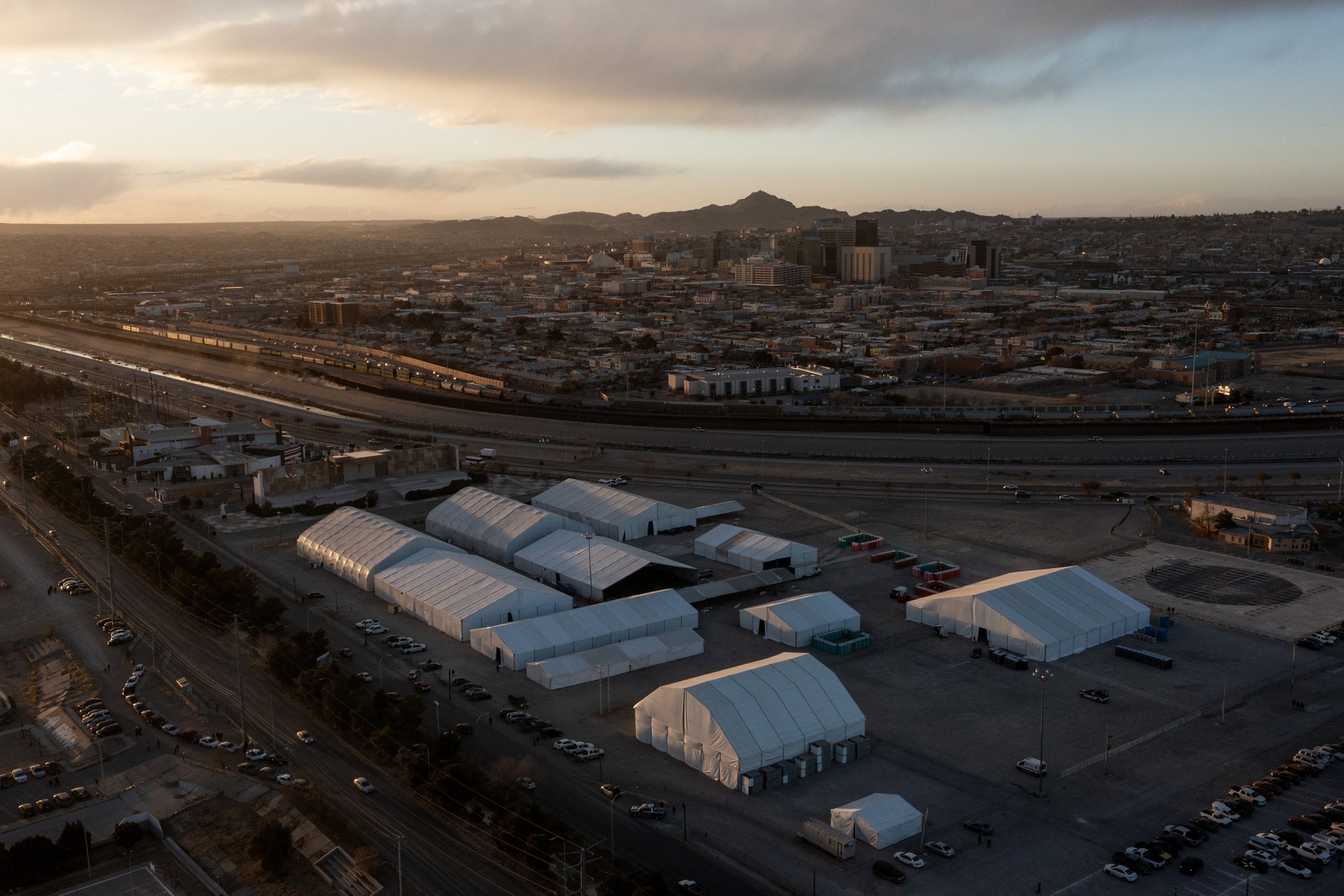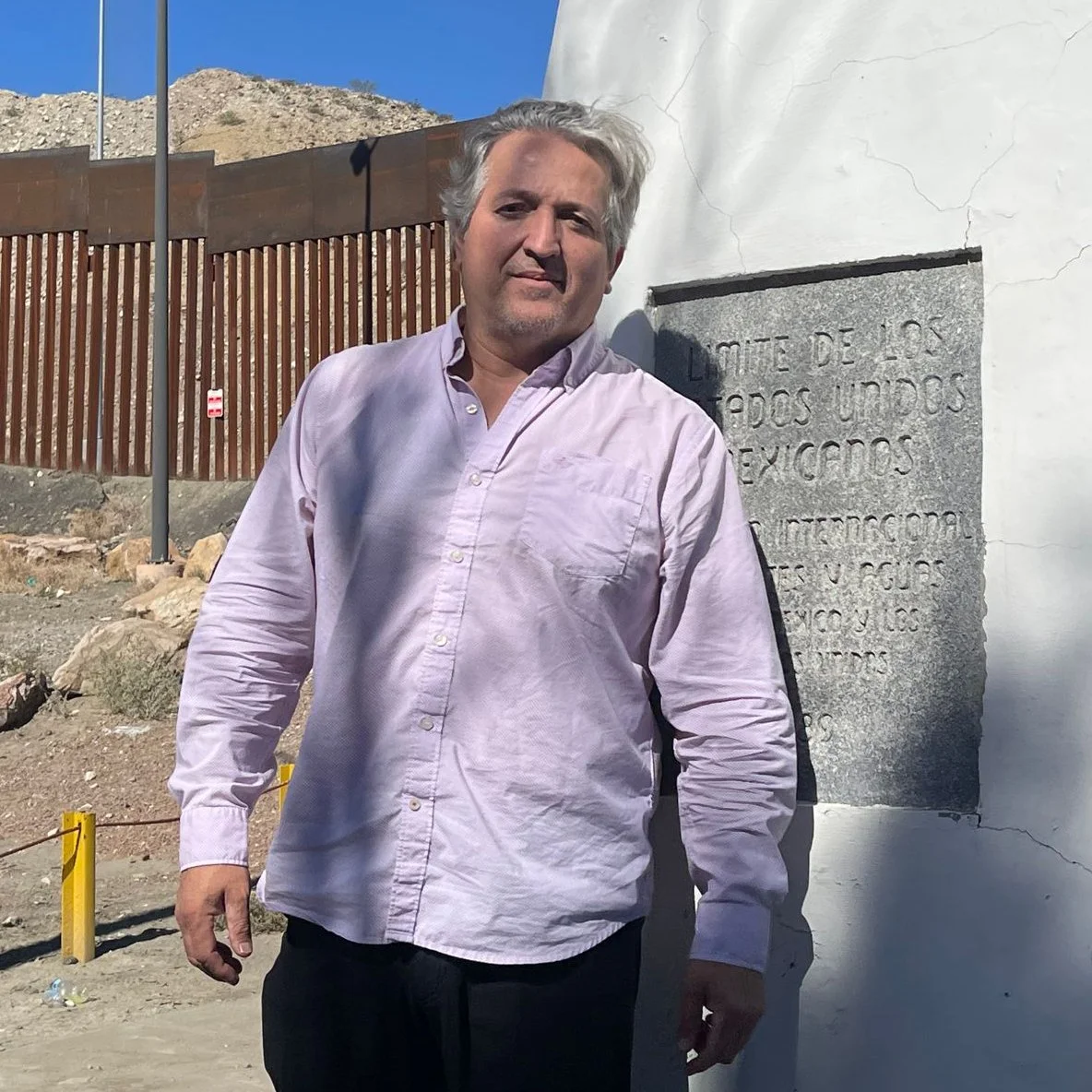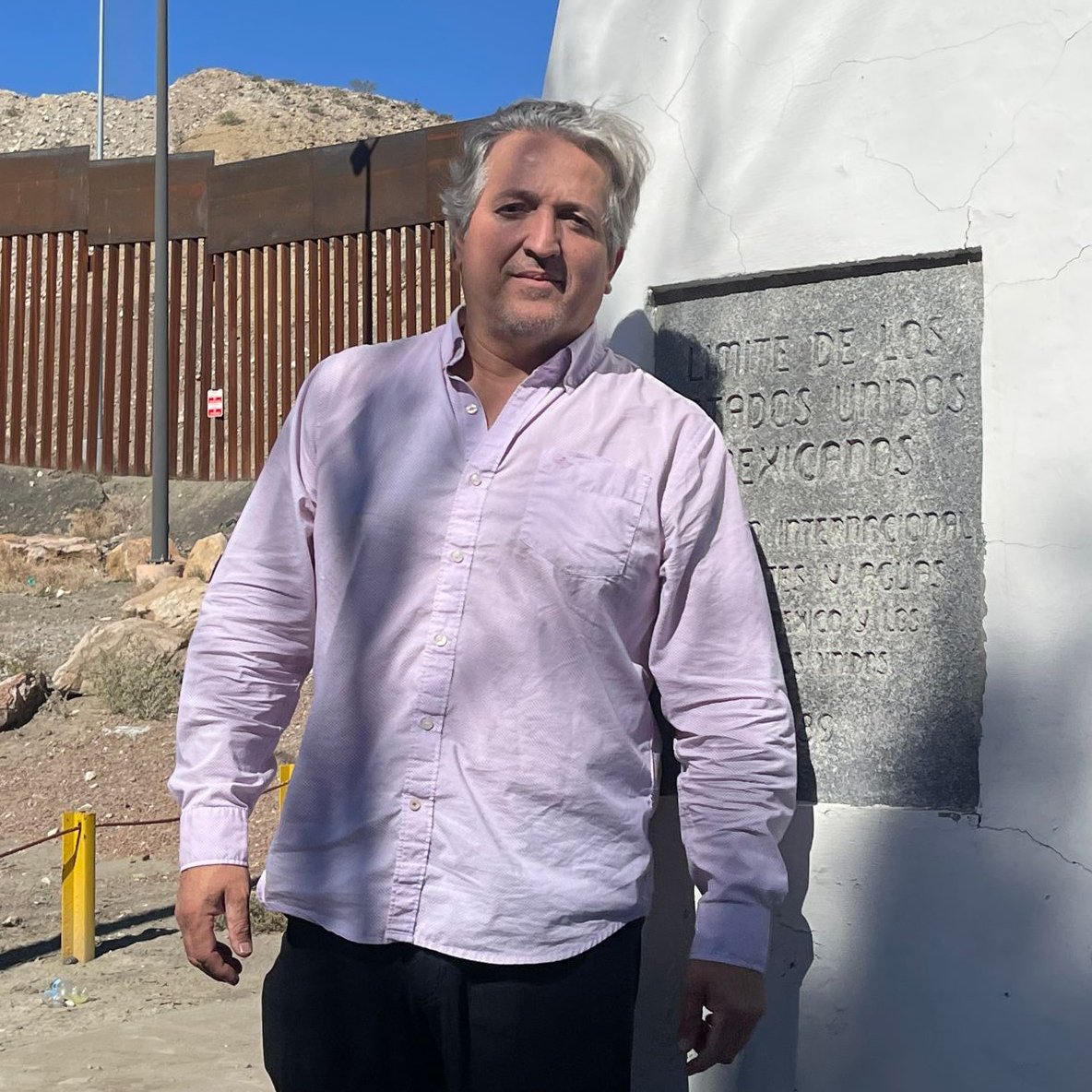Trump Storm Looms Over Mexico, Border
A shelter for deported Mexican nationals, established by the Mexican federal government, is set up in Ciudad Juárez, south of the border wall from El Paso, Texas. Photo by Omar Ornelas/El Paso Times/Puente News Collaborative
As Trump revives hardline immigration policies and tariff threats, Mexico’s president navigates a delicate balance — managing U.S. pressure, safeguarding trade, and maintaining stability. Can Sheinbaum’s methodical approach withstand the storm?
Editor’s note: This story was co-published with Puente News Collaborative in partnership with palabra. Puente News Collaborative is a bilingual nonprofit newsroom, convener and funder dedicated to high-quality, fact-based news and information from the U.S.-Mexico border.
CIUDAD JUÁREZ, Mexico – Not two weeks into President Trump’s four-year term, nerves are jangling along the U.S.-Mexico border, deep inside both countries and beyond.
Whether tariffs or mass deportations, no country has more to lose than Mexico under the Trump administration. Some 80% of the country’s exports go to its northern neighbor. Nearly four million of the estimated 11 million undocumented immigrants in the United States are Mexicans. Here on the U.S.-Mexico border, the anxiety is fueled by Trump’s myriad threats, from a 25% tariff, to repatriations — some on pricey military flights — to a crackdown on drug dealing cartels in Mexico.
Little has happened yet
The numbers of migrants deported to Mexico so far have been underwhelming. Both the extent and duration of the tariffs Trump seems poised to announce remain unknown.
Despite the threat, President Claudia Sheinbaum and other Mexican officials remain publicly cool headed and seemingly prepared.
Sprawling tent camps were erected and prepared as deportee reception centers in Ciudad Juárez and other Mexican border cities — nine in total. Counter tariffs by Mexico and Canada have been readied.
“It’s not easy living next to an erratic neighbor," observed Jorge Villarreal, a worker helping set up a 1,500 bed shelter in Ciudad Juárez, which shares the Rio Grande with El Paso. "We have to be ready for whatever Trump decides to do. This is the least we can do for our compatriots."
Mexican workers assemble the tarp roof of a shelter intended to house deported Mexican nationals in Ciudad Juárez. Photo by Omar Ornelas/El Paso Times/Puente News Collaborative
Sheinbaum’s Strategy
Deportation is just one of many challenges Trump’s new administration poses for Mexico’s popular first female president Claudia Sheinbaum, 62, who began her own six-year term just three months ago.
As decision looms — be it Feb. 1 or March 1 the potential dates Trump himself or top-ranking officials have set to impose 25% tariffs on the U.S. closest neighbors — Sheinbaum and Canadian officials say they are ready to respond with their own. A Trump spokeswoman said Friday afternoon tariffs on goods from the United States’ three largest trading partners will go into effect on Saturday. Much as an approaching hurricane, few shrug off the storm front altogether.
“We have an open dialogue with the U.S. government,” said Mexico’s president recently in one of her daily news briefings. “So we will always keep the dialogue, it’s fundamental in the Mexico-U.S. relationship. . . and we have plan A, plan B, plan C to what the U.S. government decides.”
To highlight the repercussions that the tariffs would have on the U.S., Mexico’s Economy Minister, Marcelo Ebrard, presented a list Friday of key products that American consumers purchase from Mexico — many of which would likely see price increases if the tariffs are levied.
“Mexico is the leading exporter of finished goods to the U.S., including cars, computers, televisions, and refrigerators,” Ebrard said. “Forty million American families buy computers from Mexico. . . and they will have to pay more.”
Sheinbaum’s strategy rests on four key pillars: maintain composure, prioritize cooperation over confrontation, resist undue pressure and focus on Trump’s actions rather than his words.
"What matters is analyzing what he signs, more than what he says," Sheinbaum remarked the day after Trump was sworn in, reacting to a torrent of executive actions he quickly unleashed.
So far, the approach appears to be working, for now.
Commercial traffic heads to the U.S. from Juárez on Jan. 31, 2025, as President Trump threatens to impose a 25% tariff on imports from Mexico starting Feb. 1, 2025. Photo by Omar Ornelas/El Paso Times/Puente News Collaborative
A trained physicist and climate scientist, Mexico’s first president has provided methodical analyses of Trump’s policies. She’s explained that certain Trump policies may prove less impactful than initially feared. For example, she recently said, Trump’s executive order declaring an emergency at the southern U.S. border mirrors his first term decree in 2019, when the decision didn’t create havoc.
"This is not something new," Sheinbaum said in one of her broadcast morning news briefings.
For border residents, Trump’s actions disrupted daily life, as their livelihoods and routines are deeply connected to both countries.
But Mexico’s president's measured response may explain why the country’s financial markets have remained relatively stable — for now. Despite concern over the U.S. tariff announcement, the peso and the stock market saw only slight declines on Friday morning.
"Sheinbaum is right: we will need a cool head to deal with Trump," political analyst Carlos Elizondo noted in his column in Reforma, a leading Mexican newspaper. But Elizondo and other analysts caution that Sheinbaum’s success is far from guaranteed.
Sheinbaum has so far staved off Trump’s tariff threats by ramping up migrant detentions within Mexico and cracking down on fentanyl production and trafficking. In turn, Trump, 78, recently praised Sheinbaum and Mexico in his teleconferenced speech to the World Economic Forum in Davos, Switzerland.
Arturo Rocha, a former senior migration advisor under just departed President Andrés Manuel López Obrador, also applauded Sheinbaum but offered advice.
Mexico’s goal, as it was under the first Trump administration, must be to “avoid a collision, avoid a commercial trade war, which would have led to terrible consequences for both countries,” Rocha told Puente News.
Walking on eggshells
Along the border, worries abound among businesses dependent on Mexican trade and customers.
“We just hear the same news that everyone else is hearing,” said Robin Cowen, a Brownsville customs broker whose company does business across far South Texas. “So, you know, obviously, our clients are freaking out because 25% is a lot.”
“We don’t know how real it is,” she added. "Trump is trying to use it as leverage for certain goals, some of which are valid, like the fentanyl crisis. But we don’t want it to do more harm than good.”
Indeed, the border economy, which relies heavily on both Mexican trade and labor, could suffer mightily if Trump’s tariff threats become reality. Suddenly prices may go up at U.S. supermarkets teeming with Mexican products, from beers to avocados — both coveted year round.
“There's a lot of talk about ICE raids and deportations,” said McAllen realtor Mark Hanna, noting that one potential client has already cancelled plans to open a retail store there. “Obviously, in South Texas, our workforce is very multinational.”
U.S. troops arrived at Fort Bliss in El Paso, Texas, on Saturday, Jan. 25, 2025, for a mission briefing and training before being deployed to the southern border. Photo by Omar Ornelas/El Paso Times/Puente News Collaborative
Slow Start to Deportations
Mexican officials, meanwhile. remain confident they can handle the influx of deported migrants, as they have under past U.S. administrations. Despite the noise, little more than 6,200 Mexicans have been deported since Trump took office, Mexican officials estimate.
Reception shelters, for now, remain eerily quiet.
"Fortunately, we’re not seeing any chaos," said Enrique Valenzuela, former director of the state agency that runs Ciudad Juárez’s migrant assistance center. "At this time, things appear to be under control."
But Trump, a billionaire real estate dealer and former reality TV star, is a sucker for optics.
In recent days news crews, along with reality star Dr. Phil, have been invited to witness shackled and handcuffed migrants picked up off the streets. They’re loaded onto U.S. military jets and shipped home to Central and South America from airports, including from El Paso. Experts estimated that the military flights cost as much as three times the price of charters that U.S. immigration officials have used in the past.
At Fort Bliss in El Paso on Thursday, a U.S. Border Patrol spokesman said that among the deportees on the flight were "eight family units" that included children. Another agent shouted that while it took them many months to reach the border, the plane would fly them home in just a few hours. Television news crews, photojournalists and reporters were invited to cover the departing flight.
Migrants from Guatemala, who were in the United States illegally, board a C-17 military plane for deportation to Guatemala on Jan. 30, 2025, at Fort Bliss in El Paso, Texas. The aircraft is designed to transport 134 passengers but carried only 80 migrants. Photo by Omar Ornelas/El Paso Times/Puente News Collaborative
Trump used tariff threats after Colombian President Gustavo Petro recently refused to accept two U.S. military planes carrying deportees, who were shackled and handcuffed. Defusing the threat, Petro sent two Colombian air force planes to U.S. airports, including one in El Paso, to pick-up Colombian nationals.
Critics including U.S. Rep. Veronica Escobar, D-El Paso questioned the expense and rationale for using military aircraft. “The commercial aircraft used by the federal government actually holds more people than the C-17s held,” she said.
The charter planes used by "ICE Air" carry up to 130 passengers. Military aircraft are flying out about 80 people on each flight. "Those C-17s are meant for cargo. They're meant for big tanks," Escobar said.
Reuters reported this week that military deportation flight to Guatemala cost at least $4,675 per migrant, more than five times the $853 cost of a one-way first-class ticket on American Airlines from El Paso.
Doubling down on the optics, more than 1,500 active duty soldiers and marines have been deployed to the border. They’re joining thousands more national guard troops from Texas and other states who have been stationed here since 2021 under Gov. Greg Abbott’s Operation Lone Star border initiative with a price tag surpassing $11 billion.
Support the voices of independent journalists.
|
To both mitigate the strain on its own resources and to appease Washington, Mexican authorities have ramped up efforts to break up migrant caravans crossing the country. The measures are already having an impact, with a 52% drop in apprehensions along the border since Trump took office, according to a spokesman for Customs and Border Protections.
The mega tent facilities that Mexico is building will provide not only shelter but also food, medical care, and assistance obtaining identity documents for returning migrants, including those who decided to come back on their own. Deportees will also receive a debit card worth about $100 to help cover transportation costs back to their hometowns. Mexican businesses have pledged to make 50,000 jobs available for repatriated Mexicans.
The reception shelters in Ciudad Juárez and elsewhere anchor a broader initiative, called Mexico Embraces You, launched by Sheinbaum’s government. Workers recently moved some 1,500 mattresses still in plastic and hundreds of pink and blue portable toilets. The tents are sandwiched between a 13-foot statue of Pope Francis and a leftover Christmas billboard featuring the Grinch.
Mexican workers unload mattresses at a shelter intended to house deported Mexican nationals. Photo by Omar Ornelas/El Paso Times/Puente News Collaborative
Stranded Migrants
These days, heartbreak prevails. Hopes fade for migrants after the Biden administration’s system to regulate asylum-seekers was dismantled as soon as Trump was sworn-in.
Among those marooned in Ciudad Juárez are Bryan Arteaga, 22, his wife Gabriela, 19, and their toddler son.
In an arduous trek that began 18 months ago in Venezuela, the Arteaga crossed into Mexico early last year and spent months in Mexico City before heading north for a scheduled Jan. 21 asylum hearing with U.S. immigration officers.
Upon arrival here in Ciudad Juárez, the young family learned that the asylum app known as CBP One, and their U.S. dreams had been scrapped. Arteaga and his wife now hawk candy at a busy intersection, struggling to earn enough to pay the nightly $7.30 fee for a night at a shelter.
“You can no longer ask for an appointment," Arteaga said. “We can’t do anything, not even work. Our hope is gone and we're screwed here.”
Bryan Arteaga, his wife Gabriela Ortega and their baby are stranded in Ciudad Juárez. The Venezuelan family had an appointment with immigration officials, scheduled for Jan. 21 through the CBP One app, the day after President Trump took office. All pending appointments were canceled. Photo by Angela Kocherga/Puente News Collaborative
—
Corchado reported from Mexico City and Ciudad Juárez. García reported from Mexico City. Kocherga reported from El Paso and Ciudad Juárez and De la Rosa reported from the Texas Rio Grande Valley.
Alfredo Corchado is the executive editor for Puente News Collaborative and the former Mexico/Border Correspondent for The Dallas Morning News. He’s the author of “Midnight in Mexico” and “Homelands.” @ajcorchado
Eduardo García established Bloomberg’s Mexico bureau in 1992 and served as its leader until 2001, overseeing the agency’s award-winning coverage in the country. In 2001, he embarked on a new venture by founding his own news organization, Sentido Común. For nearly 18 years, he guided Sentido Común to become one of Mexico's most esteemed financial websites. He later merged his company with the local financial news agency Infosel, assuming roles as Editor-in-Chief and subsequently Chief Content Officer. @egarciascmx
Angela Kocherga is an award-winning multimedia journalist who has dedicated her career to reporting about the Southwest border and Mexico. In 2019 she earned a Maria Moors Cabot Prize from Columbia University for courageous reporting in Latin America. She served as Mexico bureau chief and border correspondent for a group of U.S. television stations. Kocherga currently is news director for public radio station KTEP in El Paso, and multimedia editor for El Paso Matters. She lives on the southwest edge of Texas and calls the border home. @AngelaKBorder
Pablo De La Rosa reports on local communities in the Rio Grande Valley and Northern Mexico, where he was born and raised. As a three-time award-winning radio journalist, his voice has appeared on NPR, MSNBC, Texas Public Radio, The Border Chronicle, Lighthouse Reports documentaries and more. @pblodlr
Omar Ornelas is a Mexican photojournalist based in Ciudad Juárez, Mexico. For the last 20 years, he has been reporting on and photographing farmworker labor, education, health and housing issues in California, Texas and Arizona, as well as border security and Mexican and Central American migratory flows at the U.S.-Mexico border, for the USA TODAY Network. @fotornelas
Dudley Althaus has reported on Mexico, Latin America and beyond for more than three decades as a staff newspaper correspondent. Beginning his career at a small newspaper on the Texas-Mexico border, Althaus had an award-winning 22-year stint as Mexico City bureau chief of the Houston Chronicle. After a four-year run as a Mexico correspondent for The Wall Street Journal, Althaus covered immigration and border issues as a freelancer based in San Antonio for Hearst Newspapers. He has covered every Mexican presidential election since 1988, when Mexico's troubled transition to democracy began. @dqalthaus




















